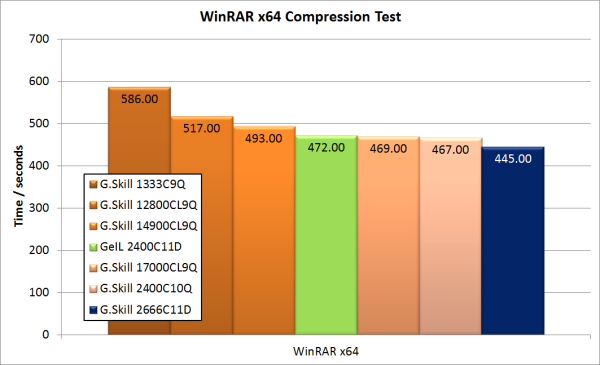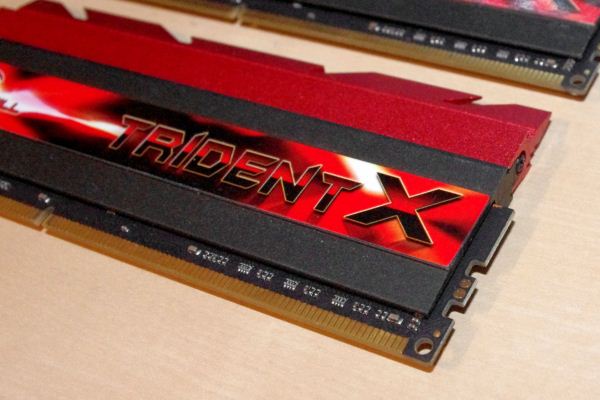G.Skill TridentX Review: 2x4GB at DDR3-2666 C11-13-13 1.65V
by Ian Cutress on October 28, 2012 12:00 PM ESTConclusions
Trying to argue the case for a 2x4 GB DDR3-2666 C11 kit for $170 is a monumental task. 4x4 GB kits of 2400 C10 offer double the capacity at a similar price point with no real change in real-life performance. Arguably neither does 4x4 GB 2133 C9 which is even cheaper, or 2x8 GB 2400 C11 which offers the same amount of modules but double the density.
From our benchmarking results, the 2666 C11 was predicted by MemTweakIt to come out on top, and in all the benchmarks we have that show results, it did, often by the smallest margins. The biggest difference seems to be with respect to WinRAR, where for our 450+ second test the 2666 C11 kit performed 22 seconds faster than a 2400 C10 kit. If that 5% change can be justified in the price for what you do, then this kit could be for you.
The only other placement for this kit is really in the hands of extreme overclockers. I am a competitive overclocker – it is one of my hobbies that I find fascinating, even if it is only trying to get a number on a screen higher than the next guy. But overclocking is like drag racing for computers – there are very few people in the market to purchase these kits compared to the majority of users that need memory. As a kit for overclockers, it works quite well, hitting 2800 C11 without a bump in voltage, and I was able to boost this to 2950 C11 with a bump in voltage. No doubt with some more knowledge and tweaking this could break the 3000 MHz barrier.
The immediate future for memory still lies in DDR3 – the next iteration, DDR4, is still several years away. We are told that on the Intel side of things, Haswell is DDR3, as will be Broadwell, the Haswell replacement. Reports expect DDR4 to be less than 10% of the market in late 2014 (early adoption in the high end space), but 50%+ across 2015. DDR4 is expected to have a base speed of 2133 MHz up to 3200 MHz for initial enthusiast applications – though given the rise in enthusiast speeds this could seemingly be pushed to 4266 MHz+ over the course of the development cycle. DDR4 is also expected to be a single module per channel, paving the way for up-to-quad channel in the mainstream arena.
But for now, if synthetics matter, then the 2x4 GB F3-2666C11D-8GTXD 2666 C11 TridentX kit offers some overclocking headroom. All other increases (at XMP) are marginal at best from previous kits. Kits like this will become more commonplace when processors adjust the tested IMC rated speed – the high end Trinity processors are rated at 1866 MHz minimum, so it only needs to raise another 1000 MHz or so. This should hold true in 2015 when DDR4 is part of the desktop hierarchy.
If you are on the lookout for a 2x4 GB memory kit, as of 10/18, here is what Newegg looked like:
| 2x4 GB Memory Kits | ||||||||
| 1600 | 1866 | 2000 | 2133 | 2400 | 2600 | 2666 | 2800 | |
| CL 7 |
$73 Corsair $70 G.Skill $70 Mushkin $65 Mushkin |
|||||||
| CL 8 |
$60 Crucial $55 Corsair $55 G.Skill $55 Crucial $55 Mushkin $53 G.Skill $53 Crucial $52 Mushkin $52 Corsair |
$75 G.Skill | ||||||
| CL 9 |
$86 Corsair $48 G.Skill** $47 Kingston $47 Corsair** $46 Avexir $45 G.Skill** $45 Kingston $45 Avexir** $44 Patriot** $43 Kingston** $42 Corsair $42 ADATA $42 Kingston $42 Mushkin** $41 Corsair $41 Kingston $41 Patriot and below |
$90 Corsair $75 Corsair $60 Mushkin $60 Avexir $55 G.Skill $55 Kingston $55 Crucial $55 Mushkin $53 Crucial $53 Kingston $52 Corsair $52 PNY $50 Corsair $50 G.Skill $50 Kingston $50 Patriot $50 Crucial $50 Team $49 Corsair $49 G.Skill $48 GeIL $47 Patriot $46 Kingston $44 Corsair |
$75 Corsair $68 Mushkin $65 Avexir $60 Corsair $60 Mushkin |
$130 Corsair $120 Corsair $110 Corsair $70 Corsair $70 Avexir $65 Mushkin $64 G.Skill $62 Team $61 G.Skill $60 G.Skill $60 Mushkin |
||||
| CL 10 |
$85 PNY $60 Mushkin $56 Team |
$100 Avexir $85 Mushkin $82 Team $77 Corsair $75 G.Skill $72 G.Skill $70 G.Skill |
$168 Team $165 G.Skill |
|||||
| CL 11 | $45 Samsung | $49 Kingston* |
$58 Corsair $57 Patriot $56 Corsair $55 Team $50 G.Skill $50 Kingston $50 Patriot $50 Team $50 GeIL |
$103 G.Skill $95 Team $77 Patriot $75 GeIL $60 Kingston |
$180 Kingston $170 G.Skill $160 Corsair $160 Avexir |
$600 G.Skill | ||
| CL 12 | $270 Avexir | |||||||
|
* Plug and Play ** Low Voltage |
||||||||
Please note this table does not take into account warranty or any 'extras' or sub-timings that may come from each kit.












28 Comments
View All Comments
Denithor - Monday, October 29, 2012 - link
Seconded.While it's kinda nice to know the RAM companies CAN produce this level of product, for 99.999% of even your audience (the true computer geeks) these products are a useless waste of cash.
I would much rather see more in depth reviews of other components, RAM speed is just so unnecessary in the overall performance of the system.
Tech-Curious - Friday, November 2, 2012 - link
I think reviews like this one are useful precisely because they show, in exhaustive detail, that high-performance RAM is wasteful.Granted, a lot of us don't need in-depth reviews to know that, but FWIW, I'll toss this article in my bookmark folder and link it whenever I need to demonstrate to someone that they should buy cheaper RAM.
mpdugas - Monday, October 29, 2012 - link
Jeepers, why all the hate?Gen-An - Tuesday, October 30, 2012 - link
No idea. If it's not for some people, fine, move on. Why they even bother wasting their time reading and replying to a review on a product they feel is "pointless" is beyond me.Beenthere - Monday, October 29, 2012 - link
Unless people have more money than brains no one really should be paying a premium for RAM with a frequency higher than 1866 MHz. as there is nothing of substance to be gained from it - as countless tests with real applications confirm. The bogus RAM tests that exaggerate the benefits of higher frquency RAM may dupe the gullible, but those with more PC knowledge know better than to be deceived.saturn85 - Tuesday, October 30, 2012 - link
add a folding on cpu benchmark should be great.Gen-An - Tuesday, October 30, 2012 - link
Ugh, you got the single-sided sticks with Hynix H5TQ4G83MFR. Most enthusiasts prefer the double-sided sticks with Hynix H5TQ2G83CFR ICs as they have more headroom than their 4Gbit counterparts. On the other hand, I have a kit of 4x4GB Trident X 2666 and I can't run all 4 sticks at 2800 C11 with stock voltage, though I haven't tried binning the sticks individually. People hate the Trident X 2400C10 sticks when they're single-sided Samsung.Beenthere - Sunday, February 17, 2013 - link
Only gullible sheeple think paying hundreds of dollars for RAM that offers no tangible improvement in system performance is a wise decision.Quote:
"Moving up to 2666 C10 obviously has the advantages of the lower command rate."
Hint: C10 is NOT the Command Rate which is either 1T or 2T